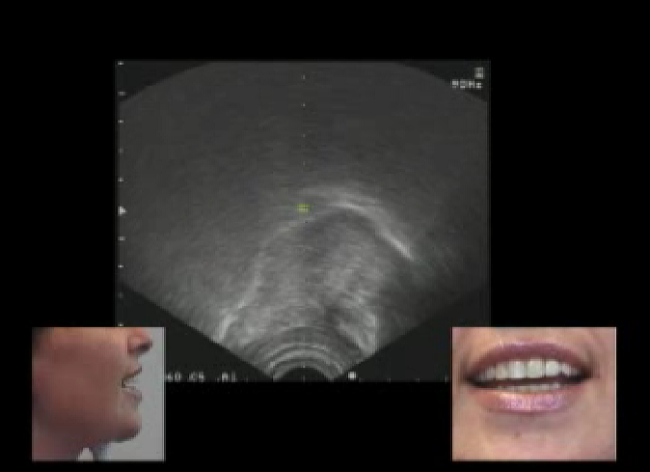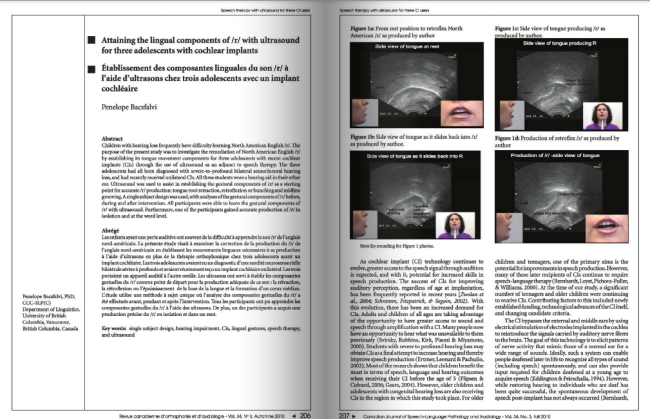Portable Ultrasound Systems for Speech Language Pathology

Ultrasound as a visual feedback tool is fast becoming a well used resource in the field of speech language pathology. Pioneers Dr. Penelope Bacsfalvi & Dr. May Bernhardt began doing clinical research using ultrasound in 2000, and Dr. Bacsfalvi has been using it clinically ever since: she completed her doctoral dissertation in this area developing methods for clinical practice; and has now been using ultrasound with children, who are both hearing and deaf, successfully for 15 years. Since then, many other clinicians and researchers have begun to use ultrasound and tout its possibilities for clinical use. Dr. Penelope Bacsfalvi says, “I have been using this tool clinically since 2000 and I cannot imagine practicing without it, especially for people with persistent speech disorders or who have a hearing loss.”
Through her mentoring of clinicians across B.C., there are now several speech pathology ultrasound systems around the province. In fact, in the spring of 2015, the Richmond School District’s SLPs worked with about 40 children using ultrasound and had great success.
For a look at the tongue movements during speech production with ultrasound, Bacsfalvi & Radanov developed a video reference tool that provides the viewer with new information in 2D: “The ultrasonic wave reflects the displayed images that show tongue shape and dynamic movement. The sagittal view displays images from the tongue tip to the tongue root. The coronal view shows any midline grooving or the relative height of the sides and midline of the tongue”.
The Fall 2010 issue of the Canadian Journal of Speech-Language Pathology and Audiology included an in-depth article by Penelope Bacsfalvi on “Attaining the lingual components of /r/ with ultrasound for three adolescents with cochlear implants”. Children with hearing loss frequently have difficulty learning North American English “R”, and Bacsfalvi’s study helped to establish the tongue movement components of the pronunciation of this sound, which was used to teach the participants; one of whom was able to accurately produce the sound after the duration of the study.
Another published study from the mid-2000’s confirms how promising ultrasound as a visual feedback tool in speech therapy:
Ultrasound has shown promise as a visual feedback tool in speech therapy. Rural clients, however, often have minimal access to new technologies. The purpose of the current study was to evaluate consultative treatment using ultrasound in rural communities. Two speech-language pathologists (SLPs) trained in ultrasound use provided consultation with ultrasound in rural British Columbia to 13 school-aged children with residual speech impairments. Local SLPs provided treatment without ultrasound before and after the consultation. Speech samples were transcribed phonetically by independent trained listeners. Eleven children showed greater gains in production of the principal target /[image omitted]/ after the ultrasound consultation. Four of the seven participants who received more consultation time with ultrasound showed greatest improvement. Individual client factors also affected outcomes. The current study was a quasi-experimental clinic-based study. Larger, controlled experimental studies are needed to provide ultimate evaluation of the consultative use of ultrasound in speech therapy.
In addition, this critical review by Lauren Gallagher adds further insight into the evolution of research and clinical ultrasound:
This critical review examines the effects of ultrasound technology as a visual biofeedback tool as an adjunct to speech therapy on the productive speech intelligibility of adolescents and young adults with moderate to profound hearing impairments. Study designs include: case study and single subject design. Overall, research suggests a facilitative role of this technology in developing more typicaltongue placement for challenging phonemes particular to this population to increase intelligibility, with hope for long-term effects. However, the evidence base for this field of research is limited and the studies reviewed demonstrate methodological weaknesses. Recommendations for future research and clinical practice are provided.
The SeeMore PI 7.5MHz Speech Language Pathology 99-5544|99-5537 portable ultrasound system can help with current or future studies like these, providing real-time display of ultrasound images on desktop, notebook and tablet devices. For more information, check out the specs on our website, or contact us. As exclusive worldwide distributors for Interson Corporation, the manufacturer; we will be pleased to guide you as required.


